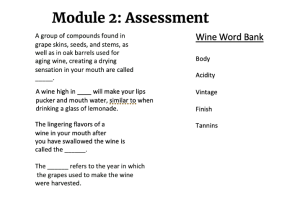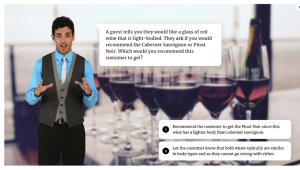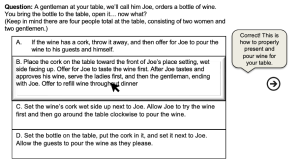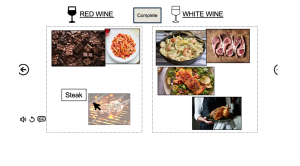5 Evaluation
E-learning Goals
The goals are to increase restaurant sales, improve customer satisfaction, and have learners learn about the traits and characteristics of wine, wine terminology, wine etiquette, and wine service.
Kirkpatrick Levels
Level 1 Reaction: Learners will be asked to assess the usefulness of wine knowledge gained for on-the-job purposes. Managers and leaders will be asked about any improvements in the workplace as well (server time management, sales, customer satisfaction, etc.).
Level 2 Learning: Engagement, pre-and post-assessments, module assessments, and final video project will determine the learner’s knowledge obtained throughout the course.
Level 3 Behavior: On-the-job success will be monitored by managers of the specific establishment who can rely on the course for extra support if more is needed for specific learners.
Level 4: Results: Increased time-management at tables, increased customer satisfaction, increased sales, confidence enhanced.
Assessment Techniques and Tools
For this course, no formal grading will be used. Learners will have unlimited attempts for each assessment. Management of the restaurant/establishment that the learner is a part of will be able to evaluate and decide if the learner needs to continue on with training. For example, if Learner A gets an 80% average score on the quizzes, Manager A may decide that that score is acceptable. However, if Learner B gets an 80% average score on the quizzes, Manager B may decide that Learner B must receive a score average of 95%. This training program can be used at many different establishments with different levels of importance when it comes to wine service. This is why a one-size-fits-all grading scale is not used. Learners can navigate throughout the course as they like as well.



Formative assessments at the end of each module will allow learners to know how well they are progressing in the course. A pre-and post-assessment will also be used to measure knowledge retained during the course.
Learners will know that they have completed the course after they have finished the final project which is a staged video of them recommending, opening, and serving wine to a customer and also by completing the post-assessment.
Validity and reliability will be addressed by providing clear learning objectives, ensuring and prioritizing accessibility (i.e. subtitles, and audio options), monitoring the formative assessment as well as the summative assessment, and allowing learners to leave a personal review of the course itself. The reliability of my tests will be addressed by a pre- and post-assessment.
The validity of my tests will be addressed by checking with a subject matter expert to validate the tests. Also, reviewing the test items to ensure they cover all relevant content areas of the content being measured. Validity will also be able to be assessed by how well the learner is able to perform on the job after the course is complete.
Declarative knowledge will be tested throughout certain parts of the course. For example, the modules on red and white wine, declarative knowledge will be tested about what each type of wine looks and tastes like. Procedural knowledge will be tested during the portion of the course where learners learn the steps of how to serve wine to guests.
My assessment tool will capture quantitative and qualitative data. Learners will be assessed on the colors, smells, tastes, terminology, and etiquette of wine, which accounts for quantitative data. Qualitative data that will be addressed will include the right amount of ounces to pour into someone’s wine glass.
There is no instructor for this course. Learners will receive feedback from management at the restaurant where they are employed. Management will have access to see if the learner has completed the course and further assessment (if needed) can be addressed either by management themselves or by the learner going back to certain lessons again and reviewing them
Assessment Tools – what will you use to assess?
The types of electronic assessments will include sequence, pick-one & multiple, word-bank, and drag and drop assessment types.
- the URLs to any electronic tools you’re using that are accessible online.
I will be using some videos from YouTube as well as pictures, charts, and references from various websites. The links if needed will be embedded into the learning itself.
Evaluation – how will you show that your assessments prove achieved outcomes?
Variables that will be examined to determine if the course is effective include:
- On-the-job success is monitored by managers of the specific establishment who can rely on the course for extra support if more is needed for specific learners.
- Wait staff have more efficient time management at and between tables, wait staff conduct accurate food and wine pairings, wait staff can open and serve a bottle of wine, customer satisfaction is increased, and sales have gone up.
- the kind of tool(s) you will use to test these variables (such as enrollment records, mid-course evaluation forms, and so on) ;
To test these variables, quarterly check-ins will be conducted with the restaurant/establishment through the use of evaluation forms for management (what they have observed post-course training) and wait staff (how they feel the course did/did not help them and what could be improved). Monthly sales of wine will also be examined to see if wait staff who have taken the course have sold a significant amount more of wine post-course.
Separating subjective opinions from more objective data will be done by comparing the opinions and feelings on the course itself (subjective data) to the actual data and numbers on restaurant sales, good reviews, and customer satisfaction (objective data). For example, if the learner surveys show that they did not enjoy the course itself (subjective data) yet their sales have significantly increased (objective data), it is imperative to find out why the learners did not enjoy the course (maybe it was too boring, too long, hard to navigate, etc.), rather than concluding that the course itself did not benefit the learners knowledge as a whole.
After a year of collecting data (i.e. wait staff performance, sales, customer satisfaction, management and/or learner reviews, etc.), course redesign can be discussed and implemented if needed.
Questionnaire
- What did you like about this course?
- What, if anything, was confusing or difficult about this course?
- Would this course help you perform better on the job? Why or why not?
- What suggestions do you have for improvement?
